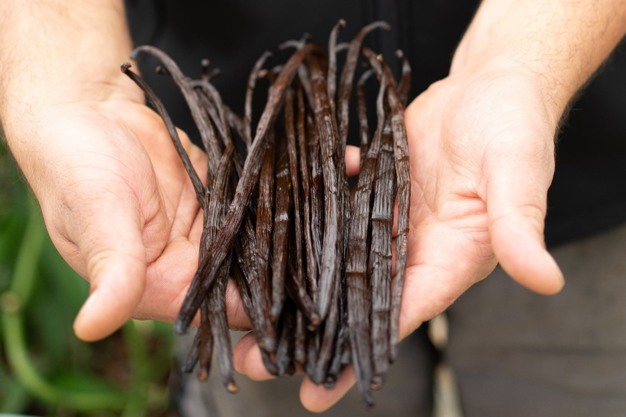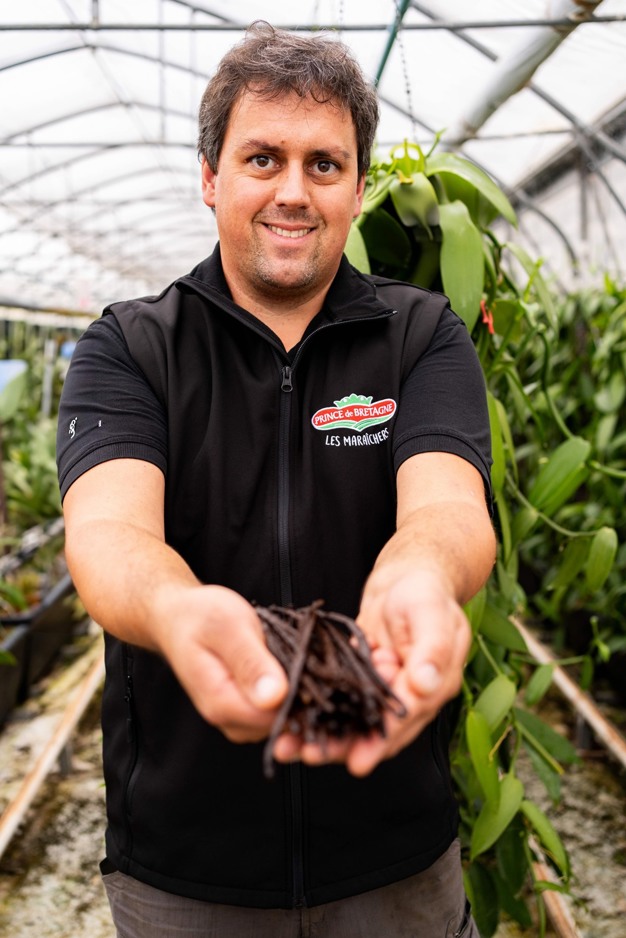It is the first vanilla harvest for some Prince de Bretagne producers, who are always on the lookout for new markets to enrich their range. After red fruits and exotic citrus fruits, 3 growers have now taken up the challenge of growing vanilla, following in the footsteps of tomato grower Pierre Guyomar. For the time being, this production is "still very confidential," but it has come about thanks to a collaboration with producers of Reunion island.

In France, vanilla is usually grown in Polynesia, Reunion or the West Indies © Prince de Bretagne
A fragile plant adapted to the Breton climate
Although the production area may come as a surprise, Brittany turns out to be a "land perfectly suited for vanilla production," as the vanilla plant (an undergrowth plant) "likes neither excess temperature nor excess light. In greenhouses, the conditions are perfectly suited to growing vanilla," confirms Pierre Guyomar, Prince de Bretagne producer and chairman of the vanilla section. In 2019, 3 growers from the Côtes d'Armor decided to start producing vanilla in existing greenhouses (former tomato greenhouses). Supported by their cooperative, Les Maraîchers d'Armor, and by Terre d'essais, the sector's experimentation station, they succeeded in the challenge of producing vanilla in Brittany. "We chose the Planifolia variety for its organoleptic characteristics, the most widely grown in the world. Although we were taking a plunge into the unknown, producers from Reunion island were not surprised. They thought it was perfectly feasible," explains Pierre. It is also thanks to 5 years of exchanging and sharing know-how with Reunion producers that the Prince de Bretagne producers have achieved their objective. In 2023, they formed a partnership with the Reunion cooperative ProVanille.
 "The work of a goldsmith"
"The work of a goldsmith"
Growing vanilla is "really the work of a goldsmith. It is very long and painstaking manual work, because vanilla is a fragile plant that respects itself and likes to be pampered. The technical solutions to production problems are still unknown, and we are constantly adapting," explains Pierre. Patience is also essential, as it takes more than 18 months from pollination to the marketing of the brown pod. "The key stage is the manual pollination of each flower between January 15th and March 15th. The Vanille de Bretagne harvest is spread out over time, 8 to 10 months later, because each pod is harvested at maturity to guarantee optimum vanilla levels."
Vanilla, a buoyant market?
"We believe in this market," says Pierre. All the vanilla from Reunion is sold locally, which proves that there is a strong demand for French vanilla. The production is still modest, "with a few hundred kilos of finished product, but we must not forget that a marketable pod weighs just a few grams, 5 times less than a harvested pod!" As for a possible increase in acreage in the years to come, "depending on the market and the first marketing year, we will adjust the volumes and welcome any Prince de Bretagne producers who would like to join the adventure."
On the photo: Pierre Guyomar
Prince de Bretagne vanilla will initially be sold to retail outlets such as specialized stores, as well as to the catering sector (ice cream shops, patisseries, restaurants...).
For more information:
Léa Marrelec Guyomard
COTACOOP
cotacoop@cotacoop.bzh
